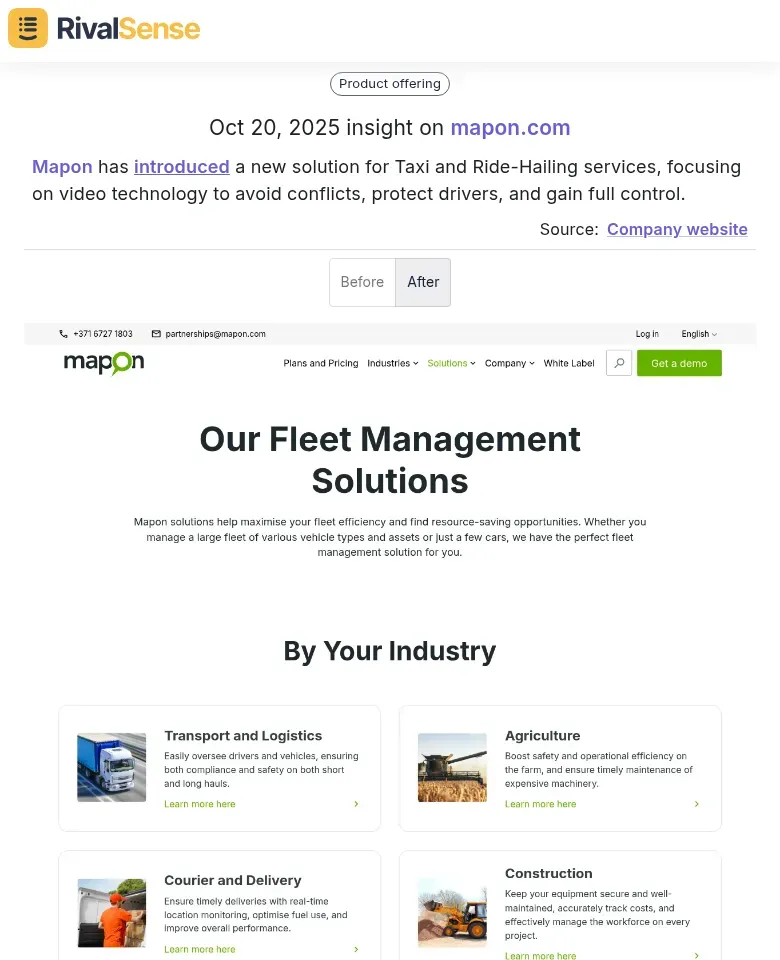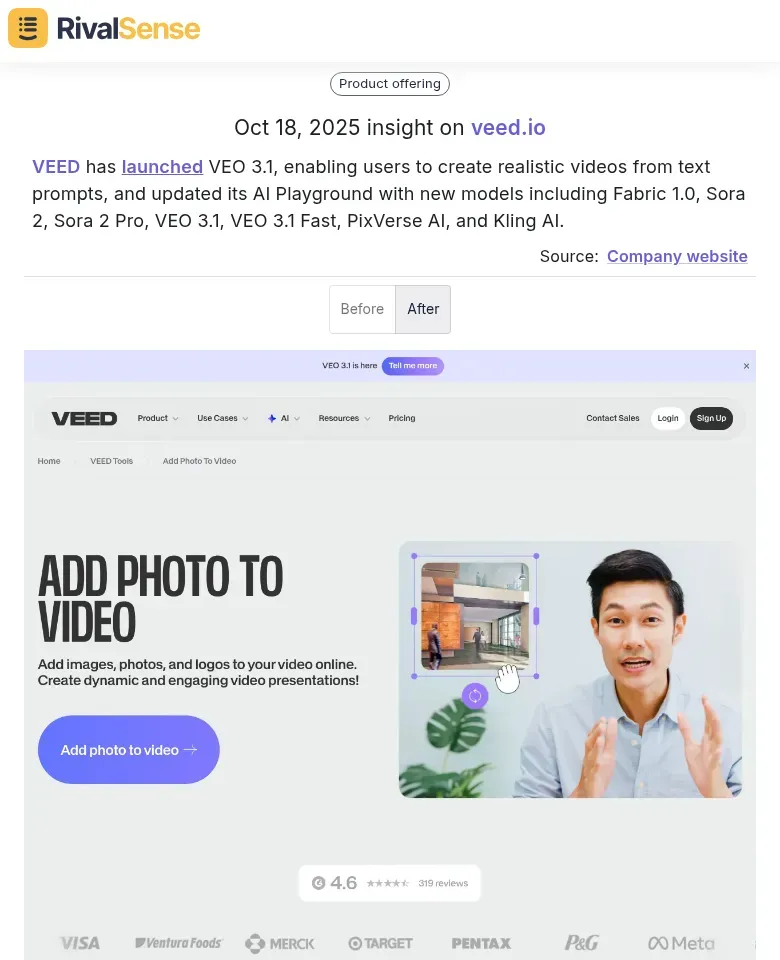Boost Productivity with Competitor Product Insights and Intelligence
In today's fast-paced market, tracking competitor product launches is essential for staying ahead. It's not just about keeping up—it's a strategic lever for driving productivity and innovation. By systematically monitoring what rivals release, you gain real-time insights that inform your own product roadmap, helping you prioritize features that address market gaps and avoid redundant efforts. For instance, if a competitor launches a new AI tool, analyze its reception to spot unmet customer needs you can capitalize on. This approach reduces endless research cycles, allowing your team to focus on actionable intelligence.
🚀 Actionable Checklist to Start:
- Set up alerts for competitor announcements
- Use tools like RivalSense to automate tracking
- Regularly review launch feedback on social media and review sites
By leveraging these insights, you'll not only accelerate decision-making but also uncover opportunities for differentiation, turning competitive moves into your advantage. Ultimately, this disciplined focus on competitor product intelligence streamlines workflows, cuts down on guesswork, and boosts overall productivity by ensuring every effort is data-driven and strategic.
Expanding Product Offerings: Learning from Diversification
When competitors diversify their product offerings, they reveal market gaps and emerging trends that can inform your strategy. Analyzing their new features or methodologies helps you understand what attracts first buyers and expands their market reach. For example, if a competitor adds AI-powered analytics, it signals growing demand for automation. Use these insights to anticipate industry shifts and adapt your product roadmap accordingly—prioritize developments that align with proven market demands to avoid wasted effort.
Consider this real-world example tracked by RivalSense: Isometric is adding methane and HFCs to its removal methodologies, with Google as the first buyer of these new credits. This type of insight is valuable because it highlights how companies are expanding into sustainability-focused areas, signaling new market opportunities and partnership potentials that you can leverage.

📈 Productivity-Boosting Checklist:
- Monitor competitor launches monthly
- Assess customer feedback on their new features
- Identify overlaps with your roadmap
- Reallocate resources to high-impact areas
This approach ensures your team focuses on innovations that drive growth, reducing time spent on speculative projects. Practical tip: Use tools like RivalSense to track competitor moves in real-time, enabling proactive adjustments and keeping your strategy agile.
Targeting Niche Markets: Insights from Specialized Solutions
Targeting niche markets offers significant growth potential when you analyze how competitors serve specialized industries. By studying their focus on specific sectors like healthcare, manufacturing, or education, you can identify underserved segments with unique pain points. For instance, if competitors are integrating video technology to address safety concerns in industrial settings, this reveals opportunities where traditional solutions fall short.
Here's an insight from RivalSense: Mapon has introduced a new solution for Taxi and Ride-Hailing services, focusing on video technology to avoid conflicts, protect drivers, and gain full control. This type of insight is valuable because it demonstrates how targeting specific niches with tailored solutions can address real-world problems, helping you identify similar gaps in your market and innovate effectively.

🎯 Practical Steps for Niche Targeting:
- Conduct competitor analysis to map their industry focus and technology adoption
- Identify gaps in their offerings where you can innovate
- Implement tools that mirror successful features, like video analytics for proactive issue detection
- Test these enhancements in pilot programs to validate effectiveness before full rollout
By emulating and improving on competitor strategies, you can capture niche markets efficiently while boosting productivity through tailored solutions that streamline workflows and reduce manual errors.
Leveraging AI and Advanced Technologies: Staying Ahead with Innovation
In today's competitive landscape, leveraging AI and advanced technologies is crucial for maintaining an edge. Tracking competitor AI model updates can fuel your own R&D and spark creativity, ensuring you don't fall behind. For example, if a rival launches a new natural language processing feature, analyze its capabilities to inspire similar innovations in your product.
RivalSense recently captured this insight: VEED has launched VEO 3.1, enabling users to create realistic videos from text prompts, and updated its AI Playground with new models including Fabric 1.0, Sora 2, Sora 2 Pro, VEO 3.1, VEO 3.1 Fast, PixVerse AI, and Kling AI. This type of insight is valuable because it reveals how competitors are rapidly evolving their AI offerings, helping you benchmark your tech stack and identify areas for improvement to stay innovative.

🤖 Actionable Steps for AI Integration:
- Set up alerts for competitor AI announcements via tools like RivalSense
- Conduct regular audits of your tech stack to identify gaps
- Train teams on new AI tools with hands-on workshops
- Implement a feedback loop to refine AI-generated content
Adopt cutting-edge tools like AI-powered content generators to enable your teams to produce high-quality outputs faster, streamlining tasks from writing to design. This approach not only boosts efficiency but also keeps your innovation pipeline dynamic and competitive.
Strategic Implementation: Turning Insights into Action
Transforming competitor insights into tangible productivity gains requires a systematic and disciplined approach. Start by integrating competitor intelligence into daily workflows to ensure it becomes a core part of your strategy. This can be achieved through automated alerts and regular review meetings that keep your team aligned and responsive.
Foster a culture of continuous learning by encouraging teams to analyze competitor moves and adapt strategies accordingly. Implement regular 'competitor deep dive' sessions where teams brainstorm responses to competitor innovations and market shifts, turning insights into actionable plans.
| Metric to Track | Why It Matters |
|---|---|
| Time saved on market research | Measures efficiency gains from automated tracking |
| Speed of competitive response | Indicates agility in adapting to market changes |
| Revenue growth from insights-driven decisions | Shows direct impact on business outcomes |
✅ Practical Implementation Checklist:
- Set up automated competitor tracking
- Create competitor response playbooks
- Establish weekly intelligence reviews
- Track competitive response time
- Measure revenue impact of insights
Focus on actionable intelligence that drives immediate productivity improvements while building long-term competitive advantage through data-driven decisions.
Conclusion: Sustaining Competitive Advantage Through Ongoing Intelligence
In today's dynamic markets, sustaining a competitive edge requires ongoing vigilance and a proactive approach to competitor tracking. By integrating this into your routine—through weekly reviews of product updates, pricing shifts, and customer feedback—you transform reactive responses into strategic advantages. This habit not only boosts productivity by streamlining decision-making but also fuels innovation, as insights from rivals can inspire your next breakthrough.
Key takeaways include regularly monitoring key competitors, analyzing their feature releases, and benchmarking your offerings against market leaders. Practical steps involve setting up alerts for competitor announcements, scheduling monthly deep-dives into market trends, and using tools to automate tracking for consistent insights.
Ready to turn competitor insights into productivity gains? Try RivalSense for free at https://rivalsense.co/ and get your first competitor report today to start making data-driven decisions that drive growth!
📚 Read more
👉 Leveraging Competitor Milestones for Strategic Insights
👉 Key Account Management Dashboard Examples: Templates, Features, and Building Guide
👉 Cloud Infrastructure Leaders: Key Account Management Strategies for Success
👉 How Atea's Incident Response Team Uncovered Hidden Competitor Advantages
